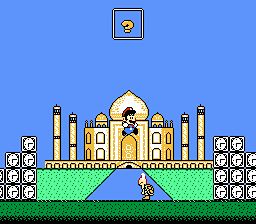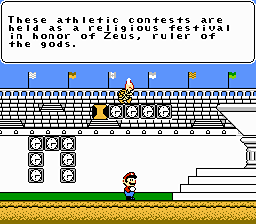
Mario's Time Machine (1994-)
Developer: Radical Entertainment
Publisher: The Software Toolworks
Genre: Educational
Mario’s Time Machine for the NES was developed by Radical Entertainment and released in 1993, with The Software Toolworks serving as the sole publisher. The game was also available on MS-DOS and Macintosh, extending its reach beyond the NES. Unlike traditional Mario platformers, Mario’s Time Machine is an educational adventure game designed to teach players about historical figures, events, and locations while incorporating exploration and puzzle-solving mechanics. It followed the educational path established by its predecessor, Mario Is Missing!, continuing Nintendo’s occasional experimentation with learning-focused titles.
The story revolves around Bowser stealing key artifacts from different points in history, prompting Mario to travel through time to recover them and return them to their proper eras. Players visit a variety of historical periods, interacting with famous figures such as Leonardo da Vinci and Abraham Lincoln. The game was inspired by the educational software trend of the early 1990s, blending historical knowledge with adventure gameplay to make learning interactive and entertaining. Its narrative focuses on historical accuracy and problem-solving rather than action, offering players an engaging way to explore history.
Gameplay involves navigating maps of historical locations, conversing with characters, and determining the correct placement of stolen artifacts. Players must answer questions and solve puzzles to ensure the artifacts are returned correctly, reinforcing historical facts through active participation. The NES version simplified certain visuals and interface elements compared to the computer releases but maintained the core educational objectives and interactive mechanics. The soundtrack consists of light, upbeat music that plays during exploration and puzzle-solving, supporting the learning atmosphere without overshadowing the gameplay.
Mario’s Time Machine serves as a direct follow-up to Mario Is Missing! and continues the franchise’s educational spin-off approach. Promotion emphasized its focus on history, interactive learning, and family-friendly content, leveraging the well-known Mario characters to attract younger players. Reception was mixed, with praise for its educational value and innovative approach but criticism from fans of traditional action-platforming Mario games who expected more dynamic gameplay. Despite this, the game remains a notable example of Nintendo’s educational experimentation, remembered for combining historical learning with familiar characters in an interactive format.
Images from MobyGames
Buy Mario's Time Machine
Click one of the Ebay or Amazon buttons below to check the latest prices and purchase Mario's Time Machine for the Nintendo Entertainment System.

Related Searches
Mario's Time Machine NES Download
Mario's Time Machine is available to purchase and download from a range of vendors. Always shop around...
Mario's Time Machine NES Manual
Various repositories around the internet have scanned and archived a range of retro manuals. Search now to.....
Mario's Time Machine NES Rom
We don't host or link to rom sites for this game. However, there are many sites out there that may be...
Mario's Time Machine NES Walkthrough
Many sites - particularly YouTube - host a range of walkthrough videos to guide you in your quest to get...
Mario's Time Machine NES Cheats
There are various sites out there that can offer cheat codes for games. Search now to find all available...
Mario's Time Machine NES Controls
This information can often be obtained through the user manual. Alternatively there are many sites out there...
Mario's Time Machine NES Release Date
The initial release date for Mario's Time Machine is stated as June 1994. Other ports of the game may..
Mario's Time Machine NES Review
There are many sites out there that have collated and documented historic reviews of this game. Search now...
Mario's Time Machine Famicom
As a Nintendo Entertainment System release, this game was also likely also available on the Famicom. This....
Mario's Time Machine NES Speedrun
There is now a community of competitive speedrunners who will try and gain the fastest possible time on their....








